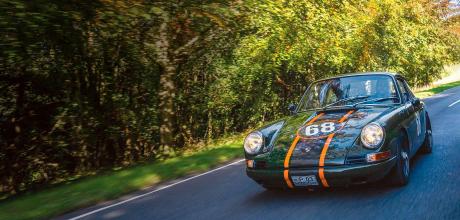175bhp 750kg Porsche 912C Restomod
This 750kg 912C rewrites the rule book on Porsche’s plucky four-cylinder ‘60s sports car. Can it rival the drive of its 911 bigger brother?
Written by Lee Sibley
GAME-CHANGING 912
750kg restomod rewrites the rule book for four-cylinder classics
912C restomod Lee Sibley test-drives this carbon-clad Porsche 912. Can it elevate the 912 driving experience to new levels?
Renowned for being underpowered if generally well balanced, historically the four-cylinder Porsche 912 has played second fiddle to its six-cylinder brethren in the mighty 911. That might well be about to change though, thanks to this striking 912C restomod created by KAMM Manufaktur.
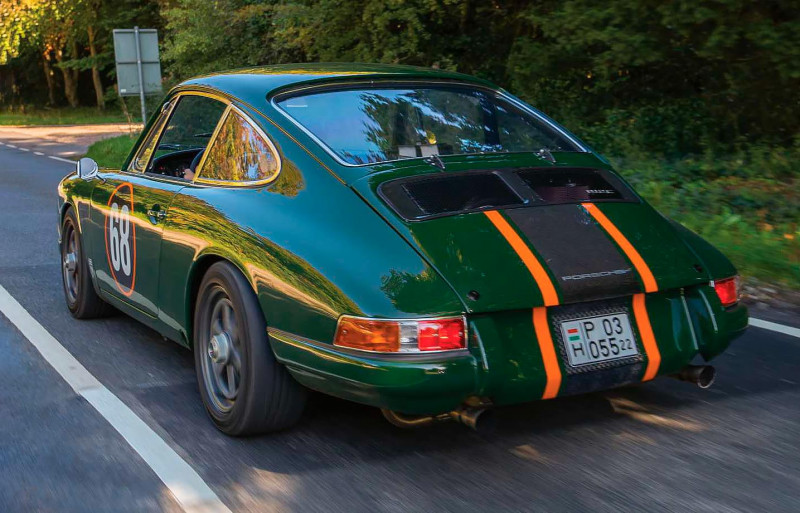
Budapest-based KAMM is the brainchild of Miki Kázmér, who founded the company in 2020. This 912C restomod is built very much in accordance with Miki’s personal taste in cars: namely, fast road or track cars, with added spice. Top-level stats here are 175hp and just 750kg wet weight, with the goal of mimicking the 1967 911R by producing a car that’s as light as possible.
Carbon fibre helps bring this weight right down (indeed, it’s what the ‘C’ stands for in this 912’s name). The material has been used to create the front wings, bonnet, bumpers, doors and decklid. Even the Talbot mirrors are carbon fibre, weighing just 40g with the mirror included. Aside from the windscreen, all glass has been swapped out for polycarbonate. Miki says the company could have gone even further with its weight-saving efforts, but it was important to retain practicality on a car that he hopes customers will readily use in future.
The 912C’s lightweight, centre-locking wheels are seven inches all round. They’re much beefier than the original 912, with 195 profile tyres on the front and 205 on the rear. Miki says this is the widest they could go without reprofiling the 912’s customary slender arches. Again, keeping that original 1960s appearance was key, which is why that carbon body has been draped in contemporary Irish green. The engine deployed is an original Type 616 used in the 356 and then 912. Completely rebuilt here from scratch (including the crank), the heads, pistons and cylinders were completed by JPS Aircooled, which used to work on these classic engines at Porsche in a race capacity, according to Miki. 44 Webers have been deployed, as has a bespoke exhaust, with programmable ignition meaning the team could create their own power curve. More on that shortly.
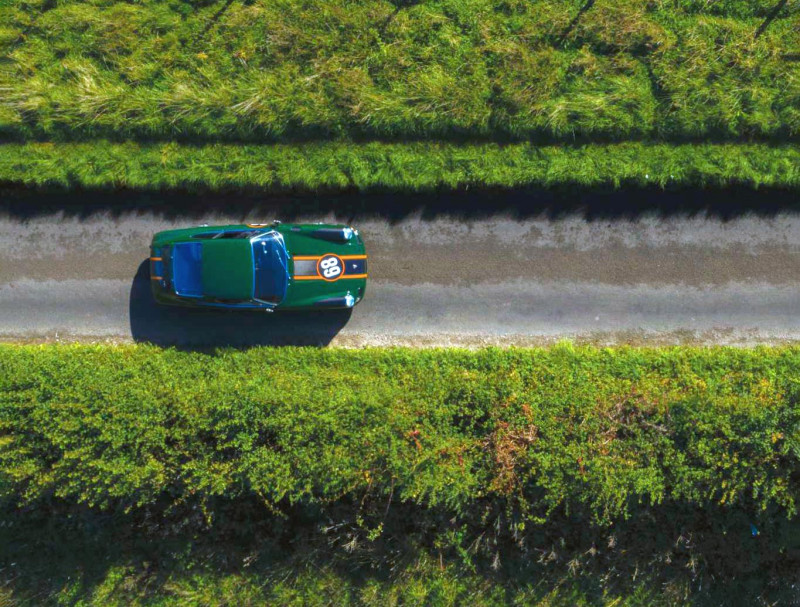
Aesthetics is important here too, as KAMM has sought to mimic the look of the iconic Porsche fourcam, four-cylinder Carrera engine. Elements of it have been remastered in carbon fibre (what else?) instead of sheet metal, with even the fan blades, shroud and scoop made from CFRP (carbon fibre-reinforced polymers). Another key difference here is the use of a modern alternator to accommodate an up-to-date electric air-conditioning system from Classic Retrofit. The big question is, why stick with the fourcylinder engine in the first place, rather than employ the more potent flat six? Well, Miki points to weight: the 912’s engine is around 80kg lighter than a comparative six cylinder, and then there’s engine positioning to consider, too. The 912 engine is mounted further forward compared to a 911 engine, so with motorsport in mind, putting more weight over the rear axle rather than past it points to better handling. The four-pot engine doesn’t mean a power deficit, either: in this trim it produces 175bhp, but it can be tuned up to 204bhp – or anywhere in between. These are mighty impressive stats in their own right, and even more so when allied to that aforementioned kerb weight of just 750kg. And there’s no driver aids to be found on this ‘60s classic, don’t forget…
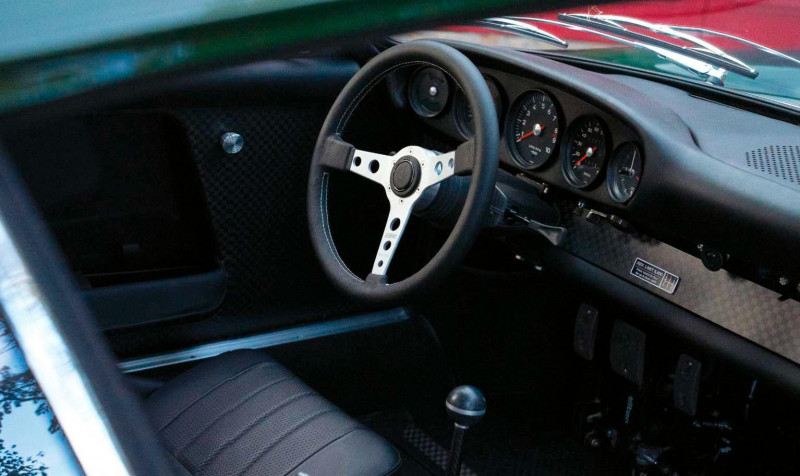
Inside, the 912C feels familiar to the original sports car made by Porsche. There’s no elaborate new dashboard or console, just a subtle yet exquisite reworking of what we already know and love about the 912. We’ll start with the shifter. It’s been moved back from its original position, which Miki describes as “almost under the dash, with a hockey puckstyle profile and a very, very, very long throw. Like a thick soup, you’re trying to find each gear, which is absolutely not what a motorsport car should feel like. We wanted to address that, and have put a lot of work into our solution.”
Said solution is to move the shifter back to where the handbrake usually is, with a very slick and purposely made short-shift mechanism that adds precision in its side-to-side movements as well as to and fro. It’s worth pointing out the big-lever handbrake isn’t a conventional parking affair but, as Miki says, “rather for the fun.”
The gearbox itself is the original five-speed 901 (the five-speed being optional for the 912 at the time), meaning it has a dog-leg first gear, although it’s a unit that’s been taken from a newer long-wheelbase model. “I love the 901 gearbox because it’s so light,” Miki says, reminding us of his wish to create a car that’s as light as feasibly possible.
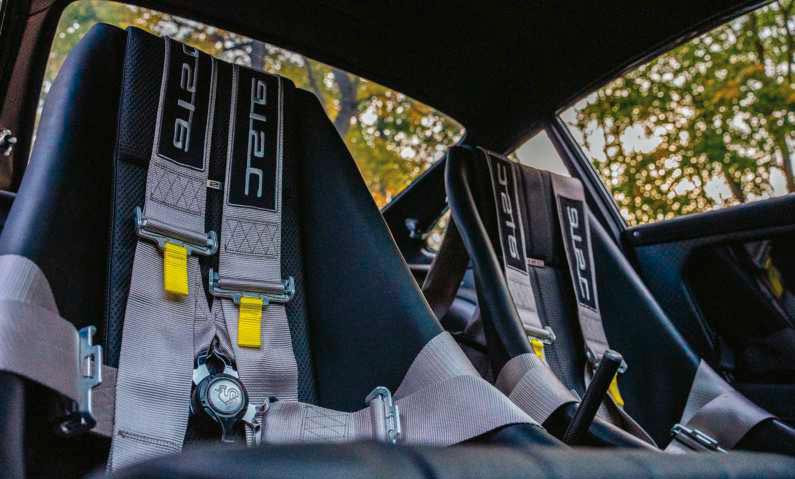
With so many parts of the car being upgraded, Miki decided it wouldn’t hurt to look at the 912’s pedals, too, which is why this 912C has been treated to a hydraulic Tilton Engineering pedal box. This helps the driver mitigate a lightweight racing clutch with the left pedal, and a two-circuit racing system with the middle.
The 912C’s steering has also been inspired by motorsport needs. Miki’s own competition experience has told him just one turn of the wheel should be all that’s required to adjust a car’s movement sufficiently, and so an increased gear ratio means it’s only 1.7 turns from lock to lock. “It’s quite tight,” Miki says with a smile.
The 912C is suspended by adjustable dampers all round, with coilovers up front and adjustable lower arms in the rear, while adjustable anti-roll bars feature at both axles. The concept of this car is admirable to say the least, so how does this tantalising specification translate out where it matters, on the asphalt?
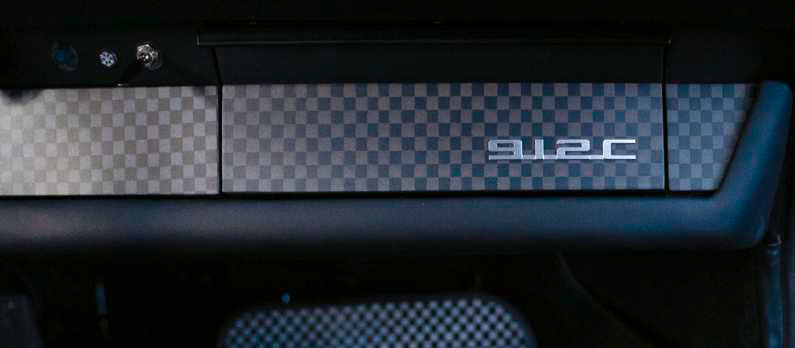
It doesn’t take long for me to find out the answer. Setting off by snicking the shifter left and then down into first, I’m soon straight up into second far quicker than I’d anticipated, the restless 912C’s engine keen to take me to 8,000rpm once more. When not shifting this delightful gearbox, both of my hands are affixed to the wheel, mitigating the lumps and bumps that attempt to knock the wheel and alter the 912’s course. I laugh, allowing the 912 to move around a little beneath me as it dances its way over West Sussex’s appalling roads.
Make no mistake, this 912C is one outrageous machine, requiring a complete recalibration of the mind as to what a 912 is and can be. The original is short on power but a real momentum car: that is, maintaining that pace, once you have it, is at the core of the 912’s charm. It’s also pretty easy to drive owing to its limited power and more neutral weight distribution. It’s a real hoot, but it’s not the full-fat experience you’d enjoy in a six-cylinder Porsche.
This KAMM creation obliterates that school of thought, unlocking every last gram of potential from the once plucky 912. Yes, it remains inherently better balanced than a 911; it is nevertheless an aggressive car that requires a lot of commitment to drive even moderately fast on the road. Its firm ride, busy steering and shorter gear ratios all contribute to positively high drama at the wheel, supported by a deep, bassy soundtrack that, at the top end, betrays the presence of a flat four.
Without a doubt, 175hp never felt so fast: the power delivery is incredibly linear with a strong mid-range and a punchy top-end, far removed from the normal 912’s sometimes breathless flat four. It’s a car that loves to be revved, right round to a mighty eight grand, and loves to be driven by the scruff of the neck at nine-tenths or more… just as a proper Porsche should.
What’s more, you can feel how light this car is, not only in the way it accelerates but in the deftness of its directional changes. The 912’s nose is very pointy, but the rear can be twitchy, so your inputs must be considered. Get it right and you’re hitting something like automotive nirvana.
In reality this setup is a little too harsh for me, but this prototype presents Miki’s own ideal, which very much errs on the side of a hardcore track car. However, he’s keen to stress the 912C can be set up to a customer’s desired spec, should your desires lean more towards road trip than race track.
To call this a 912 on steroids simply wouldn’t do the car justice. This full-on, flat-engined firebreather can be better likened to a usable ’67 911R, such is its accelerative potency and commitment to adding lightness. A genuine ’67R will set you back at least 2.5 million Euros currently, while this KAMM remastering costs €325,000 (around £281,000). With this sort of application to exquisitely remastering a humble classic, it seems the 912 need not live in the shadow of a 911 any more…
LEFT The 912C’s dash stays true to its roots, although a 911R-style window mechanism makes for a subtle nod to the car this 912C hopes to emulate.
BELOW Carbon fibre has been applied throughout to reduce weight, though this 912C’s proportions remain the same as the original.


